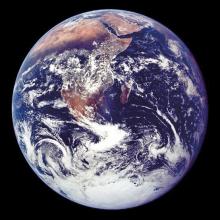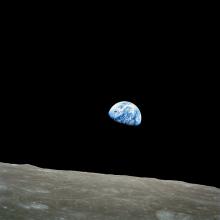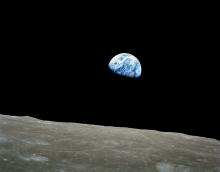You are here
Earth

But it was only in the sixteenth century, around the time of Copernicus, that people began to see Earth as a planet at all -- akin to the "wanderers" that were seen crossing the night sky against the stable background of stars. Since then, telescopic and probe-based studies of other bodies in the solar system have put our remarkable home into a broader context.
We know that Earth is the largest of the "terrestrial" planets in our solar system -- the four rocky planets close to the Sun.
Earth is tilted on its axis at 23.5 degrees, which creates the seasons. When one hemisphere is tilted toward the Sun, it experiences summer. The hemisphere tilted away experiences winter. Spring and fall occur when a hemisphere is between these two extremes.
Earth is the only planet where the normal temperature range allows water to exist on its surface as a liquid. In fact, oceans cover 70 percent of Earth's surface.
This is an extremely important factor for life as we know it.
Earth's atmosphere is another factor that makes life possible. Consisting of 78 percent nitrogen, 21 percent oxygen, and traces of other gases, it provides protection from most of the Sun's harmful radiation. It also protects us from most of the meteors that head for the planet; they burn up in the atmosphere before they can hit the ground.
The solid portions of Earth form three layers. The top layer is the crust, and is made of silicates -- rocks like quartz, feldspar, and others. The mantle lies beneath the crust, and contains most of Earth's mass. The mantle is made primarily of silicon, magnesium, and oxygen. The mantle wraps around a two-layered core: a partially molten outer layer of iron and nickel and an inner layer of solid iron. As Earth rotates, these layers spin at different rates, which generates our planet's magnetic field.
Earth's seven continents sit on large tectonic plates that float atop the mantle. Eons ago, the continents were joined together into a single land mass scientists have coined Pangaea. Starting about 200 million years ago, the plates began to drift apart, causing the continents to separate. They are still moving today, albeit extremely slowly. Earthquakes occur where tectonic plates run into each other and one plate is forced to slide underneath another.
Earth's Moon
Earth's partner in its yearly trek around the Sun, the Moon, is geologically dead. Dried lava fields called "maria" -- Latin for seas -- cover its surface, along with impact craters. The maria formed about four billion years ago, when giant asteroids punched holes in the Moon's crust, allowing molten rock to bubble to the surface, where it cooled and hardened.
Earth and the Moon are more like a double planet than a planet and a moon. The Moon is quite large in comparison to Earth -- about one-quarter of Earth's diameter. The two gravitationally interact with each other, most famously causing Earth's ocean tides.
The interaction has other important consequences. Over time, the Moon's rotation has become tidally locked, so that the same side of the Moon always faces Earth. And the Moon acts to stabilize a "wobble" in Earth's axis. Over billions of years, this has led to a much more stable climate, which was friendly to the evolution of life. The Earth-Moon interaction also slows Earth's rotation by about two milliseconds per day per century.
The Moon probably formed in a "big whack."
The theory arose after scientists analyzed the rocks brought to Earth by Apollo astronauts and Soviet Luna probes, as well as the readings of seismometers left on the lunar surface to record "moonquakes."
Their studies showed that the Moon's composition closely resembles that of Earth's crust and mantle. From this, scientists concluded that a Mars-sized body hit Earth within a few million years of its formation. The impact vaporized much of the material in Earth's crust and mantle and blasted them into space, forming a ring around the planet. This material quickly coalesced to form the Moon -- Earth's steady companion in its never-ending trek around the Sun.
The Distance Between Earth and the Moon is Increasing
Just like a spinning ice skater whose rotation slows as he extends his arms, the Earth-Moon distance is lengthening because Earth is spinning slower each day. The Moon's gravitational influence is slowing Earth's rate of rotation down by one and a half thousandths of a second every 100 years. The loss of rotational energy — angular momentum, for the physicists in the crowd — is necessarily matched by an increase in the Moon's angular momentum, which results in a larger orbit for the Moon.
Currently, the Moon moves less than two inches a year farther away from Earth — a tiny amount, but easily measurable with modern laser-ranging devices.
Keywords
At a Glance
| Name |
| From Old English |
| Average Distance from Sun |
| 92,955,820 miles 149,597,890 km 1 Astronomical Unit |
| Mass |
| 1 Earth mass 5,973,700 x 1021 kg |
| Equatorial Diameter |
| 7,926 miles 12,756 km |
| Length of Day |
| 24 hours |
| Length of Year |
| 365.24 Earth days |
| Known Moons |
| 1 |
Teacher Copies
Request a free copy of The Solar System or Beyond the Solar System for your classroom. Bulk copies are available for $1.50 each in quantities of 30 or more. Shipping is included. Call 512-471-5285 for orders of 30 or more.
 The Astro Guides for the Solar System and Beyond the Solar System are supported by the National Aeronautics and Space Administration under Grant Nos. NNG04G131G and NAG5-13147, respectively.
The Astro Guides for the Solar System and Beyond the Solar System are supported by the National Aeronautics and Space Administration under Grant Nos. NNG04G131G and NAG5-13147, respectively.






